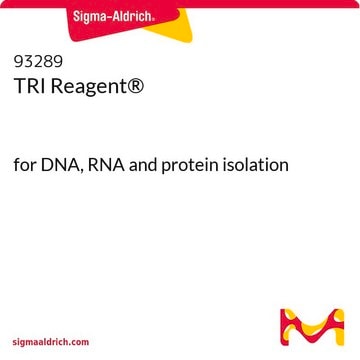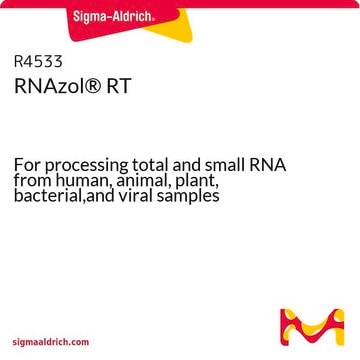B9673
1-Bromo-3-chloropropane
for isolation of RNA
Synonim(y):
1-Bromo-3-chloropropane, I-BCP, Trimethylene bromochloride, Trimethylene chlorobromide
About This Item
Polecane produkty
klasa czystości
for molecular biology
Próba
≥98.5% (GC)
Postać
liquid
współczynnik refrakcji
n20/D 1.486 (lit.)
tw
144-145 °C (lit.)
gęstość
1.592 g/mL at 25 °C (lit.)
temp. przechowywania
room temp
ciąg SMILES
ClCCCBr
InChI
1S/C3H6BrCl/c4-2-1-3-5/h1-3H2
Klucz InChI
MFESCIUQSIBMSM-UHFFFAOYSA-N
Szukasz podobnych produktów? Odwiedź Przewodnik dotyczący porównywania produktów
Opis ogólny
Zastosowanie
- feline teeth
- mice brain and liver tissues
- human ectocervical epithelial cells
- placental samples
- human mesenchymal stromal cells (hMSCs)
Cechy i korzyści
- less toxic alternative to chloroform
- compatible with TRI reagent for isolation of RNA with decreased DNA contamination
Inne uwagi
produkt powiązany
Hasło ostrzegawcze
Danger
Zwroty wskazujące rodzaj zagrożenia
Zwroty wskazujące środki ostrożności
Klasyfikacja zagrożeń
Acute Tox. 3 Inhalation - Acute Tox. 4 Oral - Aquatic Chronic 3 - Muta. 2 - STOT SE 3
Organy docelowe
Respiratory system
Kod klasy składowania
6.1C - Combustible acute toxic Cat.3 / toxic compounds or compounds which causing chronic effects
Klasa zagrożenia wodnego (WGK)
WGK 2
Środki ochrony indywidualnej
Eyeshields, Faceshields, Gloves, type ABEK (EN14387) respirator filter
Certyfikaty analizy (CoA)
Poszukaj Certyfikaty analizy (CoA), wpisując numer partii/serii produktów. Numery serii i partii można znaleźć na etykiecie produktu po słowach „seria” lub „partia”.
Masz już ten produkt?
Dokumenty związane z niedawno zakupionymi produktami zostały zamieszczone w Bibliotece dokumentów.
Klienci oglądali również te produkty
Protokoły
TRI Reagent enables simultaneous DNA, RNA, and protein isolation with sample prep guidelines and troubleshooting.
Odczynnik TRI umożliwia jednoczesną izolację DNA, RNA i białek z wytycznymi dotyczącymi przygotowania próbek i rozwiązywania problemów.
Nasz zespół naukowców ma doświadczenie we wszystkich obszarach badań, w tym w naukach przyrodniczych, materiałoznawstwie, syntezie chemicznej, chromatografii, analityce i wielu innych dziedzinach.
Skontaktuj się z zespołem ds. pomocy technicznej











